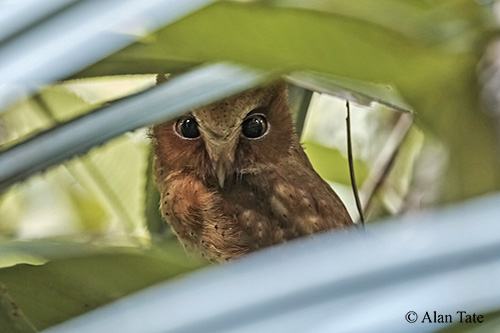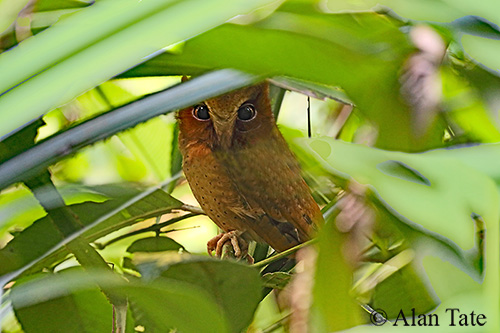
The Serendib Scops-Owl perches on thin, vertical twigs and plant stems, the most readily available perches at this level. After feeding, it usually flies higher to rest on horizontal branch. After resting, it hunts again but at higher level, between the undergrowth and the subcanopy. Then, it becomes vocal again during the last two hours before dawn.
The Serendib Scops-Owl roosts about 1 to 2,5 metres above the ground. It is usually well concealed among the dense vegetation, thanks to its cryptic plumage.
When the bird is alarmed while resting, it adopts a stance which makes it similar to a short, upright, broken branch. It tightens the body feathers to become narrower. It also adjusts the feathers of the facial disk, forehead and crown, giving it the appearance of the top of a branch. The feathers of forehead, forecrown and sides of facial disk are flattened.
These arrangements make a broader and deeper V on the forehead, showing more white than in a relaxed bird, and “false” ear-tufts become apparent.
The behaviour of this species during both breeding and nesting periods is unknown.
The pair is known to maintain the territory all year round as the species is not migratory and probably sedentary. The members of some pairs often roost very close to each other, but also sometimes well apart within the territory.
Information concerning the flight is missing, but we can suggest that like in other members of the genus Otus, the flight is deeply undulating and silent.
REPRODUCTION OF THIS SPECIES:
The breeding behaviour of the Serendib Scops-Owl is unknown.
An observation in March 2006 describes a fully-fledged juvenile roosting with an adult. The juvenile was slightly smaller, with incomplete facial disk. The eyes are yellow, like the females.
We can suggest that as numerous other Strigidae, and especially scops-owls, this species nests in cavity such as hole in tree trunk. The eggs are usually white because they are not visible inside the cavity.
More information is needed.
PROTECTION / THREATS / STATUS:
The Serendib Scops-Owl is vulnerable to habitat destruction and fragmentation.
The species is known from five sites, each of which is one of Sri Lanka’s few large remaining rainforests. These areas are administered as a Forest Reserve by the Forest Department of Sri Lanka.
The species usually occurs in rainforest patches of, at least, 8 km² in extent. It is suspected to occupy a restricted range within the island, with a total extent of 230 km² for the five sites.
Habitat loss is still continuing, caused by settlement, logging and small-scale mining operations.
The population is roughly estimated at 150-700 mature individuals, and is suspected to be declining as the remaining unprotected areas of forest are slowly lost.
The Serendib Scops-Owl is currently listed as Endangered.
Fr: Petit-duc de Sérendip
Ang: Serendib Scops-Owl - Sri Lanka Scops-Owl
All: Ceylon-Zwergohreule
Esp: Autillo de Thilo Hoffmann
Ita: Assiolo di Serendib
Nd: Serendipdwergooruil
Sd: ceylondvärguv
Photographers:
Alan & Ann Tate
AA Bird Photography
Text by Nicole Bouglouan
Sources:
HANDBOOK OF THE BIRDS OF THE WORLD Vol 5 by Josep del Hoyo-Andrew Elliott-Jordi Sargatal - Lynx Edicions - ISBN: 8487334253
OWLS OF THE WORLD – By Claus König, Friedhelm Weick and Jan-Hendrik Becking - IBSN 978-0-7136-6548-2
Owls of the World - A Photographic Guide: Second Edition – By Heimo Mikkola – Editeur: A&C Black, 2014 – ISBN: 147290592X, 9781472905925
Birds New to Science: Fifty Years of Avian Discoveries Par David Brewer – Editeur: Bloomsbury Publishing, 2018 – ISBN: 1472906292, 9781472906298 – 416 pages
A new species of scops-owl from Sri Lanka
Wikipedia, the free encyclopaedia
Serendib Scops-owl
Otus thilohoffmanni
Strigiformes Order – Strigidae Family
INTRODUCTION:
The Serendib Scops-Owl or Sri Lanka Scops-Owl is endemic to Sri Lanka where it is found in the lowland rainforests in the southwest of the island.
It was discovered in January 2001 in the southern rainforests by the prominent Sri Lankan ornithologist Deepal Warakagoda. It was formerly described as a new species “new to science” in 2004. It is the first new bird to be discovered on this island since 1868.
It was confirmed that this species appeared strikingly different from any other, both on the island and anywhere in South Asia.
The Serendib Scops-Owl is typically strictly nocturnal. It feeds on insects caught close to the ground. It roosts near the ground and often very close, well protected by the cryptic coloration of its plumage among the dry, fallen leaves in the dense undergrowth.
The pair appears to maintain a territory year-round. The breeding behaviour is currently very poorly known.
The Serendib Scops-Owl is affected by habitat loss and fragmentation usually severe in Sri Lanka. Several sites are protected against these problems, although the few remaining protected areas are slowly lost.
The species is currently listed as Endangered.
The scientific name Otus thilohoffmanni pays tribute to Thilo W. Hoffmann, an important Sri Lanka’s leading worker for nature conservation. He has proved to be a great value to the country. The name Serendib was chosen as being an ancient Persian name for Sri Lanka.
DESCRIPTION OF THE BIRD:
Biometrics:
Length: 16-17 cm
The Serendib Scops-Owl is a small, short-tailed scops-owl.
The upperparts are almost uniformly rufescent with small black spots, chevrons and bars all over the body. The scapulars may show some pale spots.
Both upperwing and tail are rufescent with rufous outer webs and mostly blackish inner webs, and broad, weak, rufous and blackish bands usually regularly spaced.
The underparts are paler and fairly uniformly sprinkled with blackish triangular spots, except on central belly and undertail-coverts which are pale and unspotted.

The head is rufescent like the upperparts, but the slightly darker rufous facial disk is weakly defined and the ear-tufts are not visible. We can see a whitish supercilium. The throat shows weak markings such as fine dark barring and dark streaking. The nape is slightly paler than the crown.
The relatively long bill is whitish to horn yellow. It is laterally compressed but not sharply curved.
The eyes are yellow to orange (most orange in adult male).
The legs are feathered on the tibia and upper tarsi. The bare parts of both legs and feet (and claws) are whitish.
Male and female have similar appearance but the female has slightly paler eyes.
The juvenile resemble adult, also with paler eyes and incomplete facial disk.
RANGE:
The Serendib Scops-Owl is found in the wet area of the southwest quarter of Sri Lanka of which it is endemic. It is mainly found in several protected forest reserves.
The range of this species overlaps with Indian Scops-owl and Oriental Scops-Owl.
HABITAT:
The Serendib Scops-Owl usually frequents the lowland rainforests from 30 to 500/1000 metres of elevation. It is also found in secondary forests with dense undergrowth.
CALLS AND SONGS: SOUNDS BY XENO-CANTO
The sounds produced by the Serendib Scops-Owl are easily overlooked. But when known, they allow recognizing and locating the species.
Within the forest, the song has a ventriloquial quality. The female gives a short, piping, tremulous, musical note “pU’U’u” rising slightly and then, falling in pitch. The notes are usually given in series and repeated at long intervals.
The song of the male is slightly lower pitched and shorter, and also less tremulous.
Male and female calls are similar in pattern, but with different tonality. The birds begin calling at dusk, and the frequency rises again two hours before dawn.
BEHAVIOUR IN THE WILD:
The Serendib Scops-Owl is strictly nocturnal and hunts at night. It feeds on large insects such as beetles and moths, and also takes small vertebrates. It usually forages close to the ground.
It begins to vocalize at dusk, but remains on roost until nightfall. Then, it flies around while searching for prey in the surroundings. The hunting behaviour is described from an observation. The species is suspected to hunt for prey in the undergrowth during about two hours after dark. It has been observed catching and consuming beetles and moths.
During this short period of two hours, no other nocturnal birds come to hunt in the same area, while later in the night, other species will come to explore these places.
